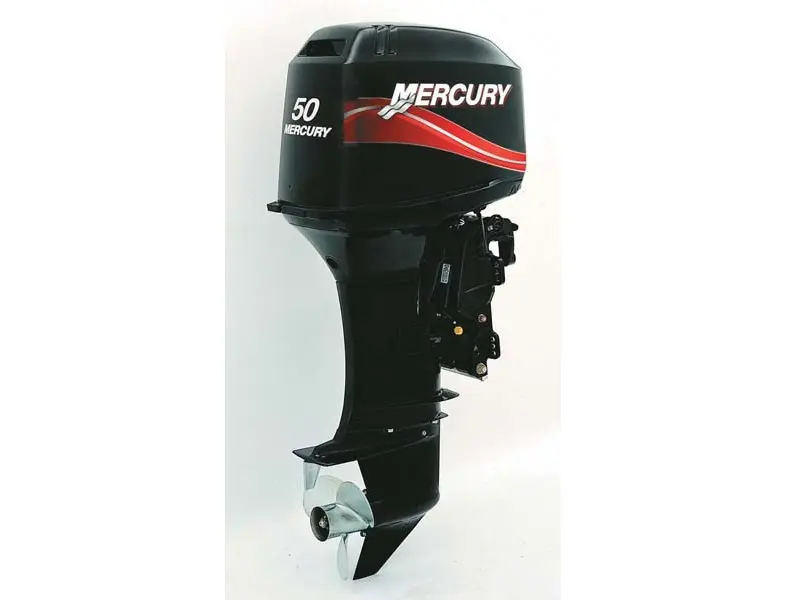
Mercury 50 Two-stroke Outboard Motor Review
Sometimes you come across an outboard motor that really stands out for its smooth operation. One such engine in the Mercury carbie two-stroke range is the crossflow four-cylinder 40. Originally a 50 from the early ’70s, no outboard in this power range ever ran as smoothly as its 718cc engine — one of the world’s smallest displacement four-cylinder outboards.
Another example is Mercury’s loopcharged three-cylinder, three-carbie Mercury 50 two-stroke. De-rated from 60hp, its 967cc piston displacement is much greater than the direct competition, enabling it to effortlessly deliver power across its entire rev range. The Mercury 50 two-stroke develops 50.0hp at 5250rpm with a WOT (wide open throttle) rev range of 5000 to 5500, and with a 1.83:1 gear ratio. It’s available in just one model — the forward-control longshaft with power trim and tilt. It has a 16amp underflywheel alternator with voltage regulation that prevents “frying” the starter battery (from overcharging) on long runs and its overall dry weight is 99kg.
Oil Injection and Maintenance Considerations
The standard oil-injection on the Mercury 50 two-stroke varies from 50:1 at WOT down to 100:1 when trolling. As with the Tohatsu “Automixing” system, it injects oil at the fuel pump, thereby ensuring the carbie butterfly throttle valves are lubricated. This system is also more reliable than multipoint oil-injection owing to the fact that it has just one injection point instead of multiple feed lines.
Users of multipoint systems should be wary of “gelling” if they mix different oil brands. This phenomenon can starve the crankshaft, bearings and piston rings of lubrication, rapidly leading to engine seizure.
The only drawback comes from long-term storage. If the engine remains unused for more than a month, a fuel stabilising additive (such as Isopropyl Alcohol) must be used to prevent fuel going stale in the carbies and blocking the jets. As with its direct carbie two-stroke competition the Mercury 50 has an OEDA “1 Star” exhaust emissions rating.
Performance on a Quintrex 488
For this test the review Mercury 50 was mounted on an old Quintrex 488 Freedom Sport bowrider (with a Maxi Transom) while spinning a 13in pitch Quicksilver alloy prop. This setup managed to effortlessly push 800kg including four adults.
It started instantly hot or cold despite running on a 50:1 break-in mix (first 10 hours) in addition to the oil injection. Quite incredibly, no oil smoke was apparent at any time. The thermostat warmed the engine quickly from cold and kept the temperature up while trolling.
When I engaged forward or reverse there was barely a “clunk” (although the single-lever Merc control box was notchy in its operation). I should also add that the engine ran so smoothly that scarcely any vibration was felt through the hull. Even with the antiventilation plate only three quarters immersed, power astern was good and no cooling-water starvation occurred.
The Mercury 50 two-stroke planed our load easily and the power trim worked quickly when necessary to maintain the best hull planing attitude. There was no prop ventilation through full lock figure-of-eight turns at WOT but prop slip was higher than expected. At or near WOT the engine was fairly raucous due to carbie induction roar.
Maintenance and Servicing
Maintenance access for the Mercury two-stroke 50hp is very good despite the massive 3.0lt powerhead-mounted oil tank, with the carbies, spark plugs and filters easily reached. Mercury Marine recommends servicing the 50 every 100 hours or annually after the initial 20-hour checkup. Recreational usage warranty is five years providing this is done by an authorised Mercury service centre.
The Verdict
Since its Australian release in 1997 the 50 has proven to be a reliable model with very good saltwater corrosion resistance, as expected of a Mercury outboard nowadays. It suits a wide range of tinnies to 4.9m and its under-stressed powerhead should deliver a long service life while remaining relatively inexpensive to own.
The large-capacity oil tank provides plenty of fishing range when an underfloor fuel tank is fitted. Spare parts should also be plentiful even in remote areas as the 50 has been around for so long (the 50 uses the same pistons as the twin-cylinder Mercury 40).
As of June 2011 the Mercury 50 two-stroke has a price of $7400 RRP with a spare alloy prop costing $410.
Mercury 50 Two-Stroke Performance
|
SPEED |
RPM |
ECONOMY |
|---|---|---|
|
2.8kts (5.2km/h) |
800rpm (trolling) |
1.6lt/h |
|
16.3kts |
4000rpm (cruising) |
10lt/h |
|
24kts (44.5km/h) |
5500rpm (WOT) |
23lt/h |
Competing Outboards
|
Engine |
Tohatsu M50D |
Yamaha 50H |
|---|---|---|
|
PRICE |
$6962 |
$7620 |
|
WEIGHT |
79kg* |
88kg* |
|
WARRANTY |
3yrs |
3yrs |
|
OEDA |
1-star |
1-star |
*These power trim and tilt engines with variable ratio oil injection are up-rated from 40hp, hence the lesser weight.
Ready to Set Sail?
Find your dream boat online at Only Boats! We have great deals on boats for sale including used boats and new boats. You can also check out our used boat buying guide.
If you're upgrading or planning to sell your boat, why not explore our expert guide on improving boat resale value? If you're planning to attend a boat show soon, we've also put together a detailed boat show buying guide that's perfect for first-time buyers.
Smooth sailing starts with the right boat. We’re here to help you find it!
This article was written by Andrew Norton and previously appeared at TradeaBoat.com.au, now powered by Only Boats.
Getting boat finance sorted shouldn't be the hard part of boat ownership. Credit One has helped thousands of Australians get on the water, earning a reputation as Australia's best-reviewed finance broker with 3,000+ glowing Google reviews to show for it. See what customers have experienced by reading their Credit One reviews, or use the loan repayment calculator to work through your options.
